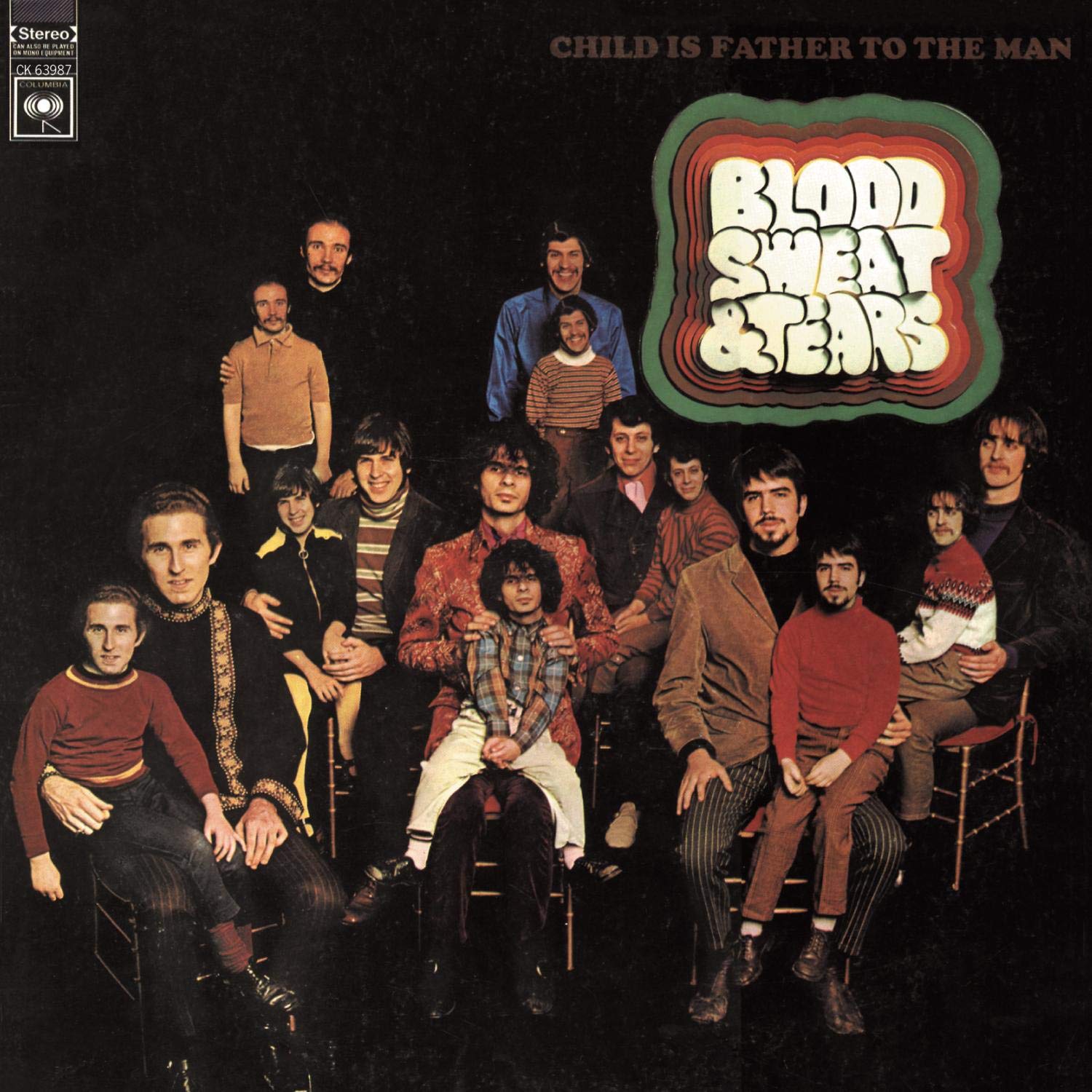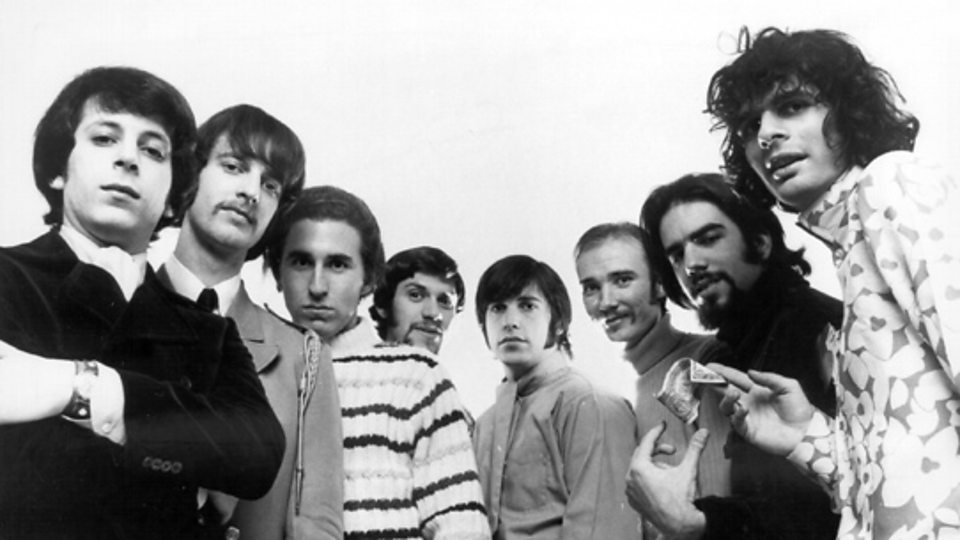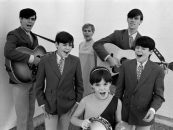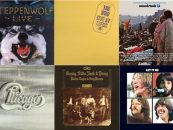Blood, Sweat & Tears—Groundbreaking Debut: Rewind
by Jeff Tamarkin If you were paying close attention to the then-burgeoning underground rock scene in the late ’60s, sooner or later you came across the name Al Kooper. He’d spent a few years as the keyboardist and one of the prime vocalists of the New York-based Blues Project, a virtuosic band whose name didn’t truly do justice to the wide scope of its music. By the time you heard them you might already have known that Kooper had written “This Diamond Ring,” a #1 hit by Gary Lewis and the Playboys, prior to joining the Blues Project. And maybe you knew that even before that he’d been with the Royal Teens, who’d had a big novelty hit called “Short Shorts” earlier in the decade. You certainly were aware that it was Kooper’s organ that helped define Bob Dylan’s “Like a Rolling Stone” in 1965.
If you were paying close attention to the then-burgeoning underground rock scene in the late ’60s, sooner or later you came across the name Al Kooper. He’d spent a few years as the keyboardist and one of the prime vocalists of the New York-based Blues Project, a virtuosic band whose name didn’t truly do justice to the wide scope of its music. By the time you heard them you might already have known that Kooper had written “This Diamond Ring,” a #1 hit by Gary Lewis and the Playboys, prior to joining the Blues Project. And maybe you knew that even before that he’d been with the Royal Teens, who’d had a big novelty hit called “Short Shorts” earlier in the decade. You certainly were aware that it was Kooper’s organ that helped define Bob Dylan’s “Like a Rolling Stone” in 1965.
By 1967 though, Kooper was searching for something new. He’d left the Blues Project and although he performed a brief solo set and helped keep things running smoothly at the Monterey Pop Festival that June, he had bigger things in mind. The 23-year-old singer-songwriter and multi-instrumentalist wanted to assemble a new group that incorporated a horn section like the one he’d heard with jazz trumpeter Maynard Ferguson several years earlier, only with more of a rock sensibility.
“Just the buzz that I would get from that band,” Kooper responded to this writer some time ago when asked what impressed him about Ferguson. “You could sit in the fourth row and have dents in your shirt from the horn section. That [Ferguson’s group] was a very exciting band for me. There had been horns [in rock bands] before but they’d been primarily James Brown-type horns. I’d heard great horns so I wanted intelligent horn parts in it. What I was really trying to do was what Chicago did on their first two albums, [although] I wasn’t as capable of doing it as they were.”
Kooper started making phone calls. First on the list was bassist Jim Fielder, formerly of the Mothers of Invention and Buffalo Springfield. Guitarist and singer Steve Katz, who’d been in the Blues Project with Kooper, was invited. “I was also frustrated with the band and wanted to have a better outlet for my own creativity,” Katz told Best Classic Bands. “It was an enticing thought to have a whole new set of songs to play and so I began writing and looking for something else.”
Drummer Bobby Colomby was added to the fledgling lineup and the quartet played a few gigs together. When they were certain they had something going, they brought in alto saxophonist Fred Lipsius, recommended by Colomby. That rudimentary lineup cut a few demo songs, enough to convince Columbia Records chief Clive Davis to sign them, and they filled out the horn section with Jerry Weiss and a young Randy Brecker, both of whom played trumpet and flugelhorn, and trombonist Dick Halligan.
Listen to “I Love You More Than You’ll Ever Know” from Child Is Father to the Man
In addition to the Ferguson influence, Kooper and Katz were both listening to the Buckinghams’ Time and Charges album and “loved how Jim Guercio used horns from the Chicago Symphony,” says Katz. “The charts were not at all R&B-oriented—it was a direction that was totally new for us, and we wanted to be able to take that kind of horn section on the road.”
Kooper named the new group Blood, Sweat and Tears, and they debuted at New York’s Cafe Au Go Go—where the Blues Project had recorded their live, debut album—in November 1967, opening for Moby Grape. The buzz was immediate.
With John Simon (who’d recently helmed Simon and Garfunkel’s Bookends) producing, recording sessions with the newly assembled octet commenced in November 1967 and wrapped in December. Child Is Father to the Man—as the album was dubbed—begins with the Kooper-penned, minute-and-a-half-long “Overture,” which symphonically previews several of the melodic themes that lie ahead.
It segues directly into one of the album’s unquestionable highlights, Kooper’s dramatic, soul-infused ballad “I Love You More Than You’ll Ever Know” (written as a tribute to the recently departed Otis Redding and later covered by Donny Hathaway), and then the album’s first cover, Tim Buckley’s poetic “Morning Glory,” sung by Katz. Kooper’s “My Days Are Numbered” is followed by back-to-back covers of Harry Nilsson’s “Without Her” and Randy Newman’s “Just One Smile,” wrapping up the original vinyl LP’s A-side.
Listen to the cover of Tim Buckley’s “Morning Glory,” as sung by Steve Katz
Another R&B-inspired Kooper original for the ages, the stomping “I Can’t Quit Her,” led off the original album’s second half, followed by Katz’s “Meagan’s Gypsy Eyes” (“my own angry little unrequited love song,” he calls it now) and three more consecutive Kooper compositions: “Somethin’ Goin’ On,” the semi-psychedelic “House in the Country” (injected with a kids’ chorus and “animal” sounds that were actually the band members) and “The Modern Adventures of Plato, Diogenes and Freud,” inspired by a psychiatrist Kooper knew. The LP closes down with Gerry Goffin and Carole King’s celebratory “So Much Love” and, bookending it all, “Underture,” an under-one-minute recap of what we’ve just heard.
Listen to “I Can’t Quit Her” from the debut album
To give the sound a boost, Simon brought in a string ensemble and female chorus (including Melba Moore and Valerie Simpson), and an array of sound effects provided by Fred Catero was layered here and there.

Blood, Sweat and Tears publicity photo from 1968 (Steve Katz is at far left, Al Kooper at far right)
“We did the album in two weeks,” Katz remembers. “We had a great time doing it. You can hear the fun we had making it. There was no pressure—nobody ever even considered the thought of hit records. We were just enjoying the ‘anything goes’ freedom that the environment of the ’60s had afforded us. Randy Brecker, Fred Lipsius and Dick Halligan (who passed away in early 2022) added much more than just playing the [horn] charts,” he adds. “They wrote the charts and added their own incredible creativity. As much credit as Al has been given, and he deserves a lot of it, it was those three that really completed the idea of what we wanted to bring about.”
Released on Feb. 21, 1968, Child Is Father to the Man was more of an underground/critical success than a commercial one at first. The album—whose front cover pictured the band members holding mini-me versions of themselves to illustrate the album title—peaked at #47 on the Billboard LP chart and there were no hit singles from it, yet the new FM rock radio stations spun it often and the nascent rock press praised the band. Jann Wenner, editor of the months-old Rolling Stone, in an April 27 feature story on the group, commented, “The horns are one of the several reasons that Blood, Sweat and Tears is such a fine, exemplary group. The other two reasons are Kooper himself. He has the gift of an editor in that he can listen for, pick up and use to his own purposes and in his own way any musical bit, any line or melody from any musical form and use it in such a way that it becomes original again.”
Related: What were some of the other musical highlights of 1968?
Word of mouth was strong enough that although the chart numbers were unimpressive, CIFttM remained on the Billboard list for more than a year and eventually went gold. It also, arguably, sparked a new craze of horn-accessorized rock bands. Kooper’s friend Mike Bloomfield, the stunning guitarist who also performed on Dylan’s “Like a Rolling Stone” and also played in a blues band (the Paul Butterfield Blues Band), left his gig around the same time Kooper did, and formed a horn band as well, the Electric Flag, which debuted at Monterey.
Kooper wasn’t impressed with some of the other bands that came along capitalizing on the idea, however. “It was in the air. [The Electric Flag] certainly were doing what they were doing without having heard us,” he said when interviewed in the 1990s. And of course, there was Chicago (originally Chicago Transit Authority). “But bands like the Ides of March, Chase and Ten Wheel Drive, I didn’t care for.”
Kooper’s tenure in his own creation wasn’t destined to last long. Following the release of the debut album, the other members of the band began wondering what a Kooper-less Blood, Sweat and Tears might be able to accomplish. Particularly, they wanted a stronger vocalist. BS&T played very few live gigs together in its original incarnation.
“I was forced out of the band,” Kooper said. “I had plenty more to do.”
In his autobiography, Clive: Inside The Record Business, Davis wrote, about Kooper’s departure from BS&T, “I was dumbfounded. ‘How in the world can you be splitting up now?’ I asked unhappily. ‘You just formed! The company is behind you; a tour is about to begin; why so soon?’”
“We have a difference of musical opinion,” Kooper told the label head. “We’ve more or less hidden it from you, but it looks like something permanent.”
Related: Kooper brought the Zombies’ now-classic Odessey and Oracle album to the attention of Clive Davis
Kooper had already begun mapping out the group’s followup album—songs like “More and More” (a Little Milton single), “You’ve Made Me So Very Happy” (Brenda Holloway) and “Smiling Phases” (Traffic)—but he never got to sing them on a recording. Kooper was ousted and replaced with Canadian singer David Clayton-Thomas. Some other members (including Brecker) bolted as well, but BS&T was only just getting started.
Released in early 1969, the group’s self-titled sophomore LP went to #1, where it stayed for seven weeks, eventually achieving quadruple-platinum sales. Three singles—“You’ve Made Me So Very Happy,” Clayton-Thomas’ “Spinning Wheel” and Laura Nyro’s “And When I Die”—each reached #2. Blood, Sweat and Tears played Woodstock that year and enjoyed a long, successful career subsequently—they’re still around in some form today, although no original members remain.
Al Kooper also enjoyed a phenomenal career post-BS&T, releasing a slew of fine solo recordings, cutting a classic collaboration with Bloomfield and Stephen Stills (Super Session) and discovering and producing Lynyrd Skynyrd, among many other accomplishments.
In 1994, in celebration of his 50th birthday, Kooper reassembled most of the original members of the original Blood, Sweat and Tears lineup for a trio of dates at New York’s Bottom Line club, to perform the album that they never got to play live the first time around. The gigs were recorded and several tracks appeared on the two-CD release, Soul of a Man.
“That reunion was one of the highlights of my life,” Kooper said after the live album’s release. “It was just transcendent. Everybody was wonderful; it was the antithesis of what it used to be like. That was a great period of work for me as a writer; it was a great bunch of songs to have written at one time. I didn’t really appreciate it until we got back together and played it again. And I really appreciated them coming back to play it again and that it meant something to them. Because of that it meant something to me again.”
Listen to BS&T cover Randy Newman’s “Just One Smile” from Al Kooper’s 1994 Soul of a Man album
Blood, Sweat & Tears’ recordings are available here. Al Kooper’s book, Backstage Passes & Backstabbing Bastards: Memoirs of a Rock ‘N’ Roll Survivor, is available here.
- The Cowsills—The Hits, the Misses & Other Things: Interview - 07/12/2025
- Zager & Evans’ ‘In the Year 2525’: The Gloomiest #1? - 07/12/2025
- Pilot’s ‘Magic’ Trick: Never Believe It’s Not So - 07/12/2025







28 Comments so far
Jump into a conversationWhy is Al Kooper not yet in the Rock and Roll Hall of Fame
We wonder about that too! He certainly should be!
Jeff, Thank you for writing about one of the more influential albums in my life. It really influenced my musical direction during my college years. Yesterday I wrote an entry on Facebook about under-appreciated musicians and Al Kooper was my number 1 entry. Thanks for a great job.
Why not, indeed. The man’s status should be nothing short of legendary.
All memorable songs from “Child….” Al Kooper has had a stunning career, and although almost blind, he has indeed seen the light.
It’s a bit weird and maybe ironic that the Kooper BS&T was so amazing and the later efforts, while certainly more financially successful, didn’t come close artistically. Al Kooper has never ceased to amaze as an artist. That he isn’t in the RRHoF is our loss.
Never get tired of playing this great album (at full volume, of course)
Thanks for interesting music trivia = keep up the good work!
I remember the Kooper BS&T as being amazing. The later group not so much. It seemed like anything that had Al Kooper’s touch was a sure bet. He certainly wasn’t mor like the later BS&T effort.
I saw the 1994 and 1996 Bottom Line shows and have great audience tapes. Why Katz didn’t want to be on the cd is a mystery to me. Those were incredible Kooper birthday shows.
Katz and Kooper had a falling out a long time ago. I’m not sure why Katz agreed to be part of the shows if he didn’t want to be on the recording, but that’s how it turned out.
Saw Blues Project at Murray the K revue in 1967. Again at Great American Hall in San Fran 30 years later. Both Katz and Kooper shoulda stayed in that band.
Hello Folks,
I don’t mean to sound snarky, but by this point it’s pretty evident that the name of R&R Hall of Fame is a misnomer, and that the hall itself is misunderstood by the majority of us, in that the mission of the organization is not about recognizing the essence of rock & roll, its musical turning points and key influences, but rather simply about record sales. If it weren’t, diverse and undeniably influential people/bands like Al Kooper, Delaney & Bonnie, Jethro Tull (to name a few) would have been inducted years ago, and a band such as the Moody Blues would have been recognized for its undeniable influence long before last year. It’s frustrating, but less so when you stop expecting the hall to represent what you think it should. It’s really not much different than the Grammys, but with a more important-sounding name. It’s such a disappointment, and such a bummer.
We’ve listed 200 artists we feel deserve to be inducted and haven’t. Search our site for Rock Hall Omissions and you’ll see those names and many others you won’t believe aren’t in there..
I really enjoyed this article about the 1st BS&T album. It’s been one of my all time favorite albums since it was 1st released. Brilliantly crafted songs with intelligent lyrics. Kooper and Karz pour their souls out on their songs. Of course all the musicians are top of the line. It’s well thought out, tracked perfectly and holds up well all these years later. I was blown away when I first heard it as a college student and now at 70, it’s one of my all alltime favorite albums. Thanks for bringing back such wonderful memories.
There is a ROIO of BS&T recorded Feb 23, 1968 at The Psychedelic Supermarket, Kenmore Square, Boston. It’s a very good audience recording and has Al singing “You Made Me So Very Happy,” “More And More,” and “Smiling Phases” – songs that DCT would record for the second album. Good stuff!
This first album is on constant rotation for me.
go to Al’s web site and listen to KooperKast – some great stuff. Can’t wait for the box
BS&T’s Dick Halligan passed away just this January (2022). His passing should have been called attention to here, but wasn’t. His playing and arranging for the group was a key element of their success.
It should be noted that Jim Fielder played on the original version of “Morning Glory” (Tim Buckley “Goodbye and Hello”, 1967).
Like so many here, I share those same feelings about BS&T first record “TCITFTTM.” In a way, the changes that came about for the group make this record seem like this record represents that group’s only album, and that future BS&T records were another group, as it were. That said, while not being an especially big fan of David Clayton Thomas’, though I’m not really sure why, I have to say that the quality of extremely innovative musicality of BS&T shined through on their subsequent records, even if the vocalist wasn’t exactly my cup of tea. I will always love their first record, as, aside from the great music on it, it’s creation in time marked a special place in music that created an indelible fondness for me. For as Jeff noted, listening to the jazz strains of “Something Going On” late at night on WNEW-FM from NYC is still as much of a thrilling memory now as it was in that hippest period of time, from where my young life took its soundtrack. But as much as I like this record, I honestly can’t deny that BS&T’s second record is every bit as good, in its own way when listened and digested as a record. Yes, it has a lot more “hits” which are actually kind of a distraction when it comes to the great jazz-oriented music throughout the record, but the greatness of the music itself can’t be denied. BS&T actually creates more cinematic music, to great effect, on their second effort. It’s just a very different kind of record, in orientation and sound, with such a distinctively different sounding vocalist. But it’s a great record, nonetheless.
Kooper’s take on “Hey Jude” shows that he had the jazz-rock idiom down cold. It’s not hard to imagine Doc and the boys playing this during a break on “The Tonight Show”.
Very rare recording of Al Kooper & BS&T performing You’ve Made Me So Very Happy: https://www.youtube.com/watch?v=nLenEHCRbsE
Thanks for the link. All six songs from the set have been posted on YT. This stuff is priceless and shows how fully formed the new songs were before the band handed them off to Clayton Thomas for LP #2..
I loved BS&T, but David Clayton-Thomas was the key that made it really take off and fly. What a singer that guy was, at least in his prime. And the musicianship was always killer. Great stuff, for sure.
You say Jim Fielder was “formerly of the Buffalo Springfield”, but he played on only one song (“Everydays”).
I thought of them as 2 completely different bands, Kooper and Thomas. Almost different genres. The later version seemed mor, AM radio oriented. Definitely more commercial successful but the Kooper version was way more visionary. The Thomas version was what you would go to see in Vegas, along with the fat Elvis.
I was just commenting the other day that the first version of BS&T had a near perfect mix of rock, R&B, jazz, pop, and anarchy. And even has a fugue sequence on “Just One Smile”! I liked the DCT version of the band fine – especially on “Smiling Phases” and “You’ve Made Me So Very Happy”, songs that Kooper had picked before his ouster – but, with apologies to the late Lew Soloff, that first version of the band was the best.
Thought it would have been cool if BS&T had been inducted in the R&RHOF at the same time as Chicago – a horn-based evening. Also, James William Guercio belongs.